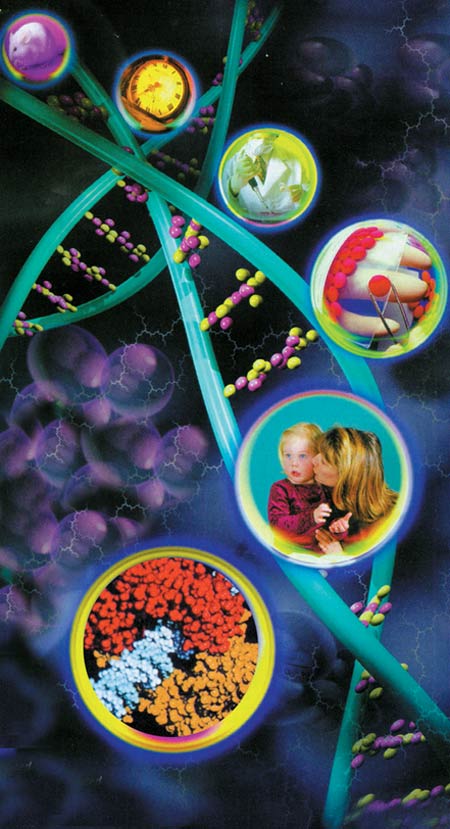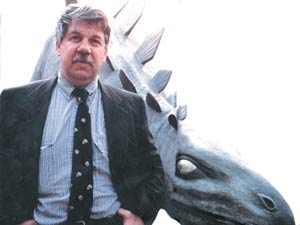G
Galapagos Islands
This group of islands in the Pacific Ocean off the coast of Ecuador contain a great many living species, particularly birds and reptiles. The miraculous diversity that Darwin observed here led him to conclude, in contrast to many others at the time, that all living things had come into existence as the result of chance. He was unable to appreciate the infinite might of God, the Creator of them all. He should have been influenced by the artistry in the universe and as a researcher, have immediately comprehended this fact. But he actually followed a logic that was diametrically opposed.
Although he collected thousands of specimen and preserved them in alcohol, he was interested only in finch species and when he investigated them, made very narrow-minded deductions. Naturally, the thinness, length of shortness of finch beaks can be examined. Yet nobody who thinks along rational and scientific lines should make a deduction solely on the basis of such an investigation about the origin of all living things—for instance how giant whales, different kinds of elephant, flies with their wondrous acrobatic ability, the butterflies with marvelous symmetry on their wings, different fish living under the sea, shellfish, birds, reptiles and, most important of all human beings possessed of reason and consciousness.
Galton, Sir Francis
Like his cousin, Charles Darwin, Sir Francis Galton was interested in biology. In contrast to Darwin, he investigated fields about which little was known: heredity and intelligence. Galton supported the idea of eugenics (which sought to improve the human race by way of heredity) for the development of inherent characteristics an individual possessed since birth. Galton’s genetic concept was adopted by Hitler, Churchill and many people who sought to eliminate “unfit” races.
K. Ludmerer states that Darwinism was the reason for the 19th century’s increased interest in eugenics:
. . . modern eugenics thought arose only in the nineteenth century. The emergence of interest in eugenics during that century had multiple roots. The most important was the theory of evolution, for Francis Galton’s ideas on eugenics—and it was he who created the term “eugenics”—were a direct logical outgrowth of the scientific doctrine elaborated by his cousin, Charles Darwin. 190
Genes
The DNA data bank found in the cell nucleus is made up of nucleic acids expressed in shorthand form by the letters A, T, G and C. The molecules represented by these letters combine together in pairs, with each pair forming a rung in the DNA. Genes emerge through these rungs, one on top of the other. Every gene, part of the DNA molecule, controls a particular characteristic in the human body.
All the physical information regarding a living thing—from height to eye color, from the shape of the nose to blood group—is encoded in its genes. There are some 30,000 genes in the human DNA. Every gene consists of between 1,000 and 186,000 nucleotides, depending on the kind of protein it corresponds to, set out in a specific sequence. These genes contain some 30,000 codes controlling the production of these proteins. The information contained in these 30,000 genes represents just 3% of the total information in the DNA. The remaining 97% is still a mystery.
Genes are found inside chromosomes. The nucleus of every human cell (with the exception of reproductive cells) has 46 chromosomes. If each chromosome were compared to a volume and each gene to a page, there is enough information in one cell—which contains all the features of a human being—to fill a 46-volume encyclopedia. That encyclopedia is equivalent to 920 Encyclopedia Britannica volumes.
 |
The letters in the DNA of every human being are arranged differently. That is why all the billions of people who have ever lived on Earth have been different from one another. The basic structure and functions of organs and limbs are the same in everyone. But everyone is specially created with such finely detailed differences. Even though each human being is the product of a single cell dividing, nobody looks exactly the same as anyone else.
All the organs in your body are constructed within the framework of a blueprint describes by the genes. For example, according to scientists, the skin is controlled by 2,559 genes, the brain by 29,930, the eye by 1,794, the salivary glands by 186, the heart by 6,216, the breast by 4,001, the lung by 11,581, the liver by 2,309, the intestines by 3,838, the skeletal muscle by 1,911 and blood cells by 22,092.
The secret behind your survival as a normal human being lies in the fact that the billions of letters in your cells’ 46-volume encyclopedia are all arranged flawlessly. It is of course impossible for these letters to organize and arrange themselves through their own consciousness and will. The genes we have compared to the pages of an encyclopedia, and their flawless arrangement that rules out the concept of chance, are proof of creation.
Gene frequency
 |
Every population—every community consisting of living members of the same species, spread over a specific area—has its own particular genetic structure. This genetic structure is determined by the population’s genotype (or individual genetic structure) and gene frequency.
Gene frequency means the percentage of the gene concerned with a specific feature of a living thing in the gene pool (a population’s genetic structure) in the total genes. In pea populations, for example, there are two genes for straight and for bent pod characters. The percentage of straight-pod genes in the overall total number gives the straight-pod gene frequency. (See Gene Pool.)
One gene frequency being higher than another means that the gene in question is found more frequently in the gene pool and therefore plays a more dominant role in any genetic variation. Evolutionists, however, seek to depict greater variation within a species as evidence for their theories. But in fact, that variation constitutes no evidence for evolution, because variation is only the product of different combinations of existing genetic information. Variation cannot endow genetic information with any new characteristic. (See Variation.)
Populations do not exhibit homogeneous distribution with regard to gene frequency. Within them, there will be small groups whose members resemble one another more closely than others. Such groups may be separated from one another for a time through geographic isolation, but gene transmission between them is not interrupted. (See Geographic Isolation theory, the.)
Gene pool
Evolutionists attempt to depict variations within a species as evidence for their theories. However, variation is no evidence for evolution, because variation consists of only the emergence of different combinations of already existing genetic information. It does not endow new genetic information with its apparently new characteristic.
Variation provides a restricted diversity within any one species. These changes are limited because they only diversify already-existing genetic information within a population. It cannot add any genetic information. All that occurs is that the genetic information that already exists rearranges itself, but the boundaries of that change remain fixed. In genetics, this limit is described as the gene pool.
All the features in the gene pool of a given species may emerge in various forms thanks to variation. For example, as a result of variation breeds with slightly longer or shorter legs may emerge in a species of reptile, because the information for leg length already exists in the reptiles’ gene pool. But variation can never attach wings to reptiles, add feathers and change their metabolisms, thus turning them into birds. Any such a transformation would require an increase in genetic information, and there is no question of any such thing in variation.
Many breeds of chicken have been bred from wild forest cocks. Yet in our day, the formation of new breeds has come to an end because the limits of change possible in the wild birds’ genetic information have been reached, and no new breeds can be produced. This kind of variation represents no evidence for evolution in any way.
The same applies in plant technology. Sugar beet is an excellent example. Starting in the 1800s, famers began producing new strains of sugar beets by cross-pollination. Following 75 years of research, it became possible to increase the beets’ sugar level from 6% to 15%. Shortly afterwards, however, improvement came to a stop. The sugar level could not be raised any further, because the limits of change permitted by the sugar beet’s genetic information had been reached, and it was not possible to enhance it any further by cross-pollination. This is one of the main examples of the limits to change in genetic data.
Genetic information
The genetic system does not consist of DNA alone. Enzymes must read the DNA code; mRNA will be produced from that reading. The mRNA will take that code to ribosomes and bond to them for production. Carrier RNA will transport the amino acids to be used in production to the ribosome. And countless other highly complex enzymes that will permit intermediate processes to be carried out must all be present.
In addition, such an environment can only be one like the cell, in which all the raw materials and energy sources are present, and which is completely isolated and controlled. (See DNA, Ribosomes; RNA World Thesis, the.)
Genetic homeostasis
Twentieth-century science revealed this principle as a result of various experiments on living things. All their efforts to produce a new species through cross-breeding were pointless, revealing that there are insuperable walls between living species. It was definitely impossible to livestock breeders breeding new variations of cows to turn cows into another species altogether, as Darwin had claimed was possible. Norman MacBeth revealed the invalidity of Darwinism in his book Darwin Retried:
The heart of the problem is whether living things do indeed vary to an unlimited extent. . . . The species look stable. We have all heard of disappointed breeders who carried their work to a certain point only to see the animals or plants revert to where they had started. Despite strenuous efforts for two or three centuries, it has never been possible to produce a blue rose or a black tulip. 191
Genome Project, the
Evolutionist circles claim that the Genome Project has proven their theory, but there is no scientific basis to this. Evolutionists engage in hollow claims that the Genome Project has definitively proven the theory of evolution, because they actually have no concrete evidence, and there is no connection at all between the Genome Project’s findings and the claims of the theory of evolution.
It is a grave error to think that causing physical changes by tampering with genes constitutes evidence for the theory of evolution. True, within the Human Genome Project defective genes in living things may be able to be put right. Certain inherited diseases may be cured, and a species may be perfected even further through altering its genes. So long as all such interventions take place at the hands of rational human beings possessed of abilities and technology, they will continue to give cures and improvements.
 |
But the most important criticism of the theory of evolution actually arises at this exact point. The theory claims that genes, proteins, all the building blocks of life—and therefore, life itself—came into being spontaneously as the result of chance, with no consciousness involved at all.
Neither science nor logic can accept such a claim of chance. With the Genome Project, it was yet again realized that life consists of exceedingly complex structures, all interrelated to one another, and that any one cannot exist without all the others. Each one of these structures has a flawless blueprint and design, and it is therefore impossible for such perfect and complex structures to come into existence spontaneously and—again by chance—to further develop themselves into even more complex structures. This shows us one certain fact: God, the Omniscient and Almighty, created life.
Another error in this regard is that some scientists think that since they can effect changes by altering genes, it is actually man who is a creator. This claim is linked to the groundless, atheistic propaganda that evolutionists bring up at every available opportunity because of their denial of God. Tempering with a living organism’s genes to produce changes is not the same as creating it. To take cloning, for example, to place a living thing’s stem cell in a womb and produce an exact copy of the life form in question is not the same as creating it in the first place.
 |
| Celera Genomics, the company that carried out the Human Genome project |
Creating means bringing into existence from nothing. And evolutionists are perfectly aware that they are quite unable even to produce a single cell from nothing. All their endeavors in this area have ended in failure. (See Fox Experiment, the and Miller Experiment, the.)
Far from proving evolution, the findings of the Genome Project have once again revealed the fact of creation.
Geographic Isolation theory, the (Allopathic isolation)
 |
| The different races on Earth came to have different features due to geographic isolation. The feature of black skin came to predominate in one group, and since these people lived on the same continent and reproduced among themselves, a black-skinned race developed. |
Living things that reproduce sexually may be subjected to geographic isolation when a land bridge collapses or continents drift apart one another. In that event, the same species in two separate regions may display different genetic characteristics. To put it another way, geographic obstacles may divide populations from one another. For example, land-dwelling animals may become separated from one another by deserts, waters, or high mountain ranges.192 If a population is divided into two or more regions, the genetic differences between them will increasingly broaden and eventually, the life forms in these different regions will develop into different breeds or races. 193
When this separation reaches such a level as to prevent gene transfer between populations, then the similarity of characteristics between the different variations of a species is diminished.
Evolutionists erroneously maintain that living things on different continents or in different environments develop into different species. However, the different characteristics arising in different regions are nothing more than population differences. The genetic combination of those life forms obliged to reproduce in any one region is restricted, and specific characteristics in their genes come to the fore. Yet there is no question of any new species emerging.
The same applies to human beings. The different races on Earth have acquired different characteristics because of geographic isolation. The feature of dark skin came to predominate in one human group, and since these people lived in Africa and reproduced among themselves, a dark-skinned race was the result. The same thing applies to Far Eastern races with their almond-shaped eyes. Were it not for geographic isolation—in other words if human races had inter-married for hundreds of years—then everyone would now be a crossbreed. No one would appear to be black, white, or oriental; everyone would be an average of all racial characteristics.
Sometimes, when variations once divided from each other due to geographic reasons are reunited, they are unable to reproduce with one another. Since they are unable to reproduce, they cease being sub-species, according to modern biology’s definition, and become separate species. This is known as speciation.
Evolutionists, however, take this concept and infer that since there is speciation in nature, and new species form through natural mechanisms, that implies that all species formed in this way. Yet that inference actually conceals a grave deception. There are two significant points to be made:
 |
1. Variations A and B, which have been isolated from one another, may be unable to reproduce when reunited again. But this generally stems from mating behavior. In other words, individuals belonging to variation A are regarded as foreign by variation B, and therefore fail to mate, even though there is no genetic incompatibility to prevent mating. In terms of genetic information, therefore, they are still members of the same species. (Indeed, for that very reason the concept of “species” continues to be debated in biology.)
2. The really important point is that speciation represents a loss of genetic information, rather than an increase. The reason for the division is not that either or both variations have acquired new genetic information. There is no such genetic acquisition here. Neither variation has acquired any new protein, enzyme or organ. No development has gone on. On the contrary, instead of a population that previously contained genetic data for different characteristics (for example, for both long and short fur, or dark and light coloring), there are now two populations, both been impoverished in terms of genetic information.
Therefore, nothing about speciation supports the theory of evolution. Because the theory of evolution maintains that all living species developed from the simple to the complex through chance. In order for that theory to be taken seriously, therefore, it needs to be able to point to mechanisms that enhance genetic information. It must explain how life forms lacking eyes, ears, a heart, lungs, wings, feet or other organs and systems came to acquire them—and where the genetic data for these features arose. A species being divided into two through a loss of genetic information has nothing to do with evolution.
Gish, Duane T.
 |
| Duane T. Gish’s books criticizing the theory of evolution |
In his address titled “The Origin of Man,” presented to the Collapse of the Theory of Evolution: The Fact of Creation conference, held by the Science Research Foundation on 5 July 1998, the world-famous expert on evolution Professor Duane Gish described why the thesis that man evolved from apes is groundless:
The fossil record refutes the evolutionary theory and it demonstrates that species appeared on Earth fully-formed and well-designed. This is a concrete evidence for that they were created by God. 194
With his books—mainly on the subject of paleontology—and the more than 500 conferences he has held, Professor Gish is one of the founders of the Institute for Creation Research (ICR), and one of the world’s most eminent critics of the theory of evolution. The ICR was founded in San Diego, California in the early 1970s, and has since become one of the most important organizations in the world to criticize the theory of evolution. The ICR has more than 20 scientists, laboratories, a large number of researchers, a faculty that offers postgraduate training, a Museum of Creation that attracts thousands of visitors every year, a team that carries out scientific research in various countries, and also publishes books and magazines and broadcasts radio programs.
Gould, Stephen Jay
 |
Although the late Harvard University paleontologist Stephen Jay Gould is one of the leading proponents of evolution theory, he criticizes evolutionary biologists in stuffing scientific literature with non-evident tales. Gould describes such stories in his following words:
Evolutionary biology has been severely hampered by a speculative style of argument that records anatomy and ecology and then tries to construct historical or adaptive explanations for why this bone looked like that or why this creature lived here… Scientists know that these tales are stories; unfortunately, they are presented in the professional literature where they are taken too seriously and literally. Then they become [scientific] "facts" and enter the popular literature…. 195
Gould, an evolutionist paleontologist, was also one of the leading theoreticians of the punctuated model of evolution. (See Punctuated evolution.) Phillip Johnson, one of the world’s leading critics of the theory of evolution, describes Gould as the “Gorbachev of Darwinism.” Mikhail Gorbachev sought to revise the system in the former Soviet Union out of a belief that it was imperfect. But in fact, the problems he regarded as imperfections actually stemmed from the nature of the system itself, and Communism finally collapsed entirely.
Gradual Evolution comedy, the
—See, Punctuated Model of evolution myth ,Great Chain of Being, the
According to the Greek philosopher Aristotle, there is a hierarchy among species, from the simple to the complex, and these are set out in a linear manner, just like the rungs of a ladder. Aristotle gave this thesis the name Scala naturae. This idea would have a profound effect on Western thought up until the 18th century, and belief in the Great Chain of Being, would later develop into the theory of evolution.
The belief that all living things evolved from inanimate matter constitutes the basis of Darwinism, but it can first be encountered in Aristotle’s accounts. Belief in the Great Chain of Being was enthusiastically adopted by philosophers who denied the existence of God.
According to this view, life came into being spontaneously and everything evolved—minerals into organic matter, and the first living primitive organisms into animals, plants and human beings, and from there to so-called deities, or gods. According to this irrational belief, new organs arise spontaneously according to a living thing’s requirements.
This belief has no scientific basis, but rather conflicts with all the scientific facts and is based solely on abstract logic. But it was most recently proposed under the name of the theory of evolution.
Initially, the Great Chain of Being was advanced as an entirely philosophical view and made no scientific claims. However, for those seeking to answer the question of how life came to be, aside from the fact of creation, the Great Chain of Being was literally a lifesaver, and was given a scientific air for that purpose.
How these organisms actually turned into one another, however, is a great mystery. Because this chain is based on an abstract and superficial logic rather than on any scientific observation. In other words, it consists of a hypothesis dreamed up by early philosophers, without engaging in any scientific research.
There is a strong parallel between the theory of evolution, which represents the basis of materialist and atheist philosophies, and the Scala naturae and Great Chain of Being that form the vital source of ancient pagan materialist philosophies. (See Evolutionary Paganism.) Today, materialism draws strength through the theory of evolution, as in the past, materialist thinking was based on the Great Chain of Being.
Darwin was strongly influenced by this concept and even constructed his theory on its principal logic. In several places in his book Darwin’s Century, Loren Eiseley emphasizes that the logic of this “ladder” was used in the 18th century and that this, in particular, was where the idea of organic substances moving inevitably towards perfection was born. 196
Therefore, Darwin did not propose any new scientific theory. He merely restated a superstition whose roots lay in ancient Sumerian pagan myths and which developed fully within ancient Greek pagan beliefs. He employed contemporary scientific terminology and a few distorted observations, and further enriched it with a number of additions made by some scientists who lived in the 17th and 18th centuries—after which it acquired a scientific appearance in Darwin’s book The Origin of Species, and finally emerged as the greatest deception in the history of science.
Footnotes
190.K. Ludmerer, “Eugenics” in Encyclopedia of Bioethics, Edited by Mark Lappe, New York: The Free Press, , 1978, p. 457. 
191.Norman Macbeth, Darwin Retried: An Appeal to Reason, New York: Harvard Common Press, 1971, p. 33. 
193.Prof. Dr. Ali Demirsoy, Yaflam›n Temel Kurallar›, Genel Biyoloji/Genel Zooloji, Vol. I, Part I, Ankara, 1993, p. 606. 
194.http://www.evolutiondeceit.com/conferences. php. 
195.Stephen Jay Gould, "Introduction," in Björn Kurtén, Dance of the Tiger: A Novel of the Ice Age (New York: Random House, 1980), xviixviii) 
